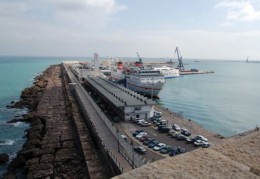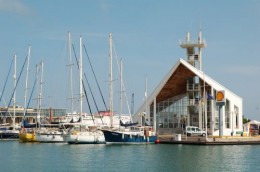Port of Melilla
Given in good faith, but not to be taken as gospel.

Melilla occupies the northern part of a large man-made harbour which is shared between Spain and Morocco. The space between the two ports seems ideal for anchoring, and indeed, we spent quite a bit of time here. If you plan to do likewise, be aware that the anchorage is directly in front of the gaping harbour mouth and is therefore completely untenable in a strong easterly. We have seen breakers five feet high rolling across this whole area in an onshore gale.
The marina lies tucked away behind its own, secondary wall and is safe and snug in all imaginable conditions. It forms the first of three basins; so, effectively you just enter the port, turn right, and then immediately turn left. If you give the marina a call before entering then someone will probably come and take your lines.
At the time of our visit a berth for a 50ft yacht cost 13 € per night. (For comparison – a berth in the marina in La Manga would have cost us 60 € per night in the winter and 110 € in the summer…)
The port has its own wifi internet service. This is frequently out of order – but when it goes down, don’t mope; go and nag the guys in the office. If you don’t nag them, they don’t even know that it isn’t working. On each occasion, when we complained, normal service was promptly resumed.

We came to Melilla with the specific purpose of slipping the boat. For a vessel of our size this cost 95 € each way, plus 6 € per day in the yard. (Maximum stay 10 days, after which the price rockets.) There were various hidden extras, such as the rent of a cradle, but even so, this was considerably cheaper than any boatyard in Mediterranean Spain. That’s not all; in Spain the boatyards will no longer let the owner apply his own antifouling. They do it for you, and they do it badly – and, of course, you have to pay. (Slipping and painting in La Manga would have cost us well over 1,000 €)
The marina is also the place to take on fuel – unless you will be visiting Morocco or the Canary Islands. The fuel in Melilla is much cheaper than in mainland Spain, but it is slightly cheaper again in Morocco, and significantly cheaper in the Canaries. (Diesel, in the Canaries, is currently around 60 € cents per litre. In Melilla the price was around 76 cents, and in Spain it was 115 cents.)
‘Ware The Wall!
Approach and entry into the port of Melilla and Nador could hardly be more straightforward, but if you are going to be mucking about within the greater harbour, which is shared between the two countries, then you need to take a good look at an up to date chart, and you need to pay close attention to your navigation and to the buoyage.
The Moroccan port is relatively new, and in the days before its stout concrete wall was built Melilla was open to the south-east. In order to alleviate this problem and make the place safer the Spanish built a stone wall, and most of that stone wall is still in situ, neatly dividing the harbour. So far, so good; a seawall is easy to spot. The problem centres on the bit of the wall that is no longer in situ.
While the Spanish were building the wall of the new marina some clever-dick had the brilliant idea of scavenging the outer 100 metres of the old seawall and recycling it, thereby saving a few pesetas. Unfortunately, whilst the exposed, upper part of the wall was easy to get at, the submarine rocks were less accessible – so they left them there.
The submerged outer end of the old Spanish seawall is vaguely indicated by a cardinal mark. The mark is of the appropriate size, shape, and colour, but it lies about 100 metres off the end of the obstruction. This may very possibly be standard practice, but in this particular situation it is malpractice.
Out in the open sea there is plenty of room to allow a good offing, but in the confines of the harbour the buoy is so far from the end of the wall that it might as well not exist. It sits more or less in the middle of the harbour, and a yacht passing from Melilla to Nador could certainly be forgiven for assuming that it was intended to keep the Big Boys out in the deeper water. Indeed, a yotty passing from one port to the other, engrossed in trying to spot a suitable place to berth, could be forgiven for not even noticing the buoy, it is so far to seaward of the rhumb line between the two ports.
A local resident told us that vessels regularly touch the wall, and some friends of ours hit it hard enough to sink their steel boat.
UPDATE: Since this article was published – and due largely to our friends’ misadventure – the authorities have finally placed a buoy at the end of thesubmerged wall. According to the shipwrecked mariners there is now, “a big yellow buoy half the way between the east cardinal and the dry end of the dyke.”
Another thing to note, if you are intent on visiting Nador, is the Moroccan paranoia regarding unscheduled, or unapproved shipping movements. If you do not want to land yourself in trouble, call them on the radio before you enter their half of the port.
For more information about Melilla, take a look at Jill’s article.

Very interesting. Could you tell me the e-mail of the marina and/or their web site, phone # and any useful info to contact them? Thank you.
I’m now in Turkey and I’d like to spend the winter there.
Have a nice sailing.
JP Duchene
s/v TANIA
Sorry for the delay in responding to your question.
The website of the marina in Melilla is http://www.puertodemelilla.es/content/view/33/71/. There are contact details on the site.